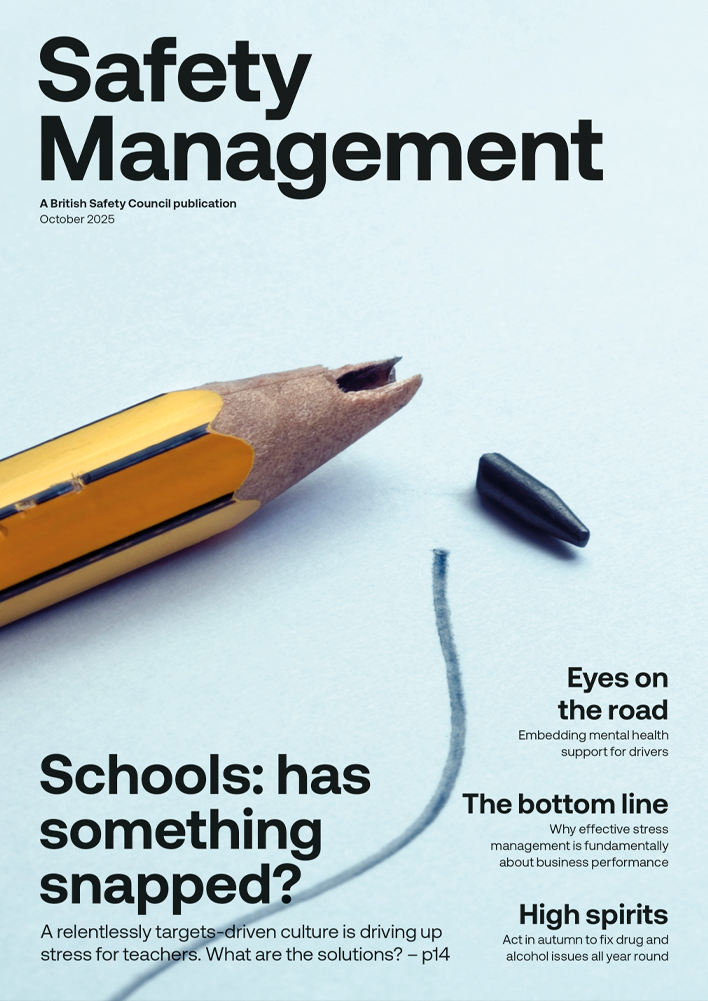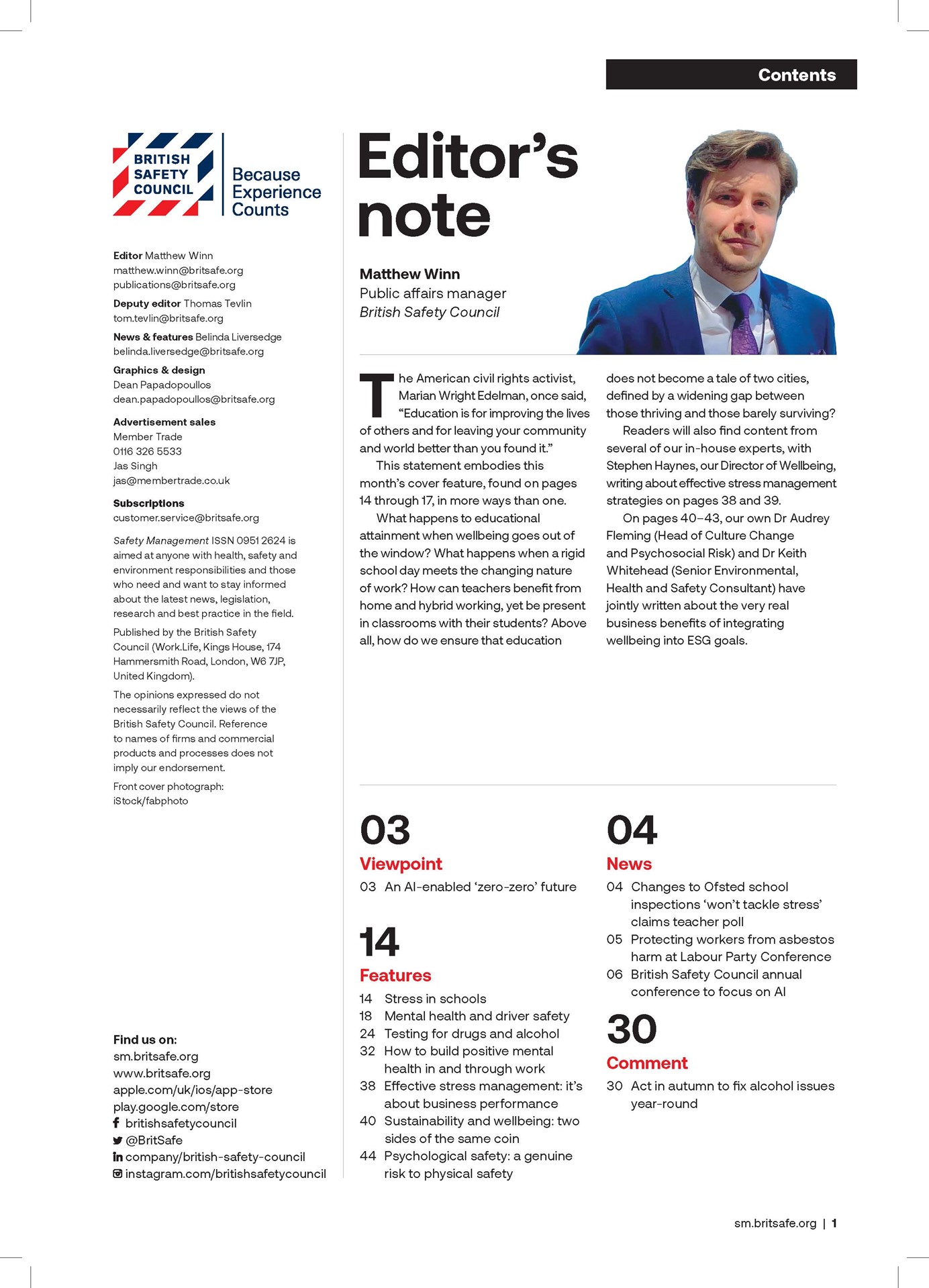We talk about health and safety, but for decades what we’ve really meant is just safety. One hundred years ago, businesses killed 5,000 workers per year from accidents. Now it’s down to less than 150. Still too many, but an achievement we should be proud of nevertheless.
Features
Beyond lifestyle initiatives
The total work-related deaths in the UK every year stands at 13,000. So, only 1 per cent of fatalities are due to accidents and 99 per cent are due to disease caused by workplace exposures. Some 12,000 of these deaths are lung related, from illness such as cancers to Chronic Obstructive Pulmonary Disease (COPD).
There’s also the bigger picture of morbidity, proving this is not just ‘grandad’s disease’. Each year, there are 13,500 new occupational cancer registrations in Great Britain and we lose 31m working days due to work-related sickness absence overall. Of that 26.7 million days (86 per cent) are due to ill health. The cost to the economy is £15 billion annually, of which £10 billion is due to ill health. And that figure doesn’t even include the cost of long-latency diseases.
There is good news though. Health is now on the agenda of both regulators and business and there is great learning we can take from our experience of managing risk in safety. But how do we begin managing the health risk when it seems complex and outside the comfort zone of many safety professionals?
The first step is to understand that there are three key elements to the whole picture of workplace health. Firstly, the classical understanding of health at work comes under the banner of occupational health. This is the clinical arena that is related to managing the health of workers. It covers the work of doctors and nurses on things like fitness for work and health surveillance. Wellbeing is the second dimension. This is about promoting healthy lifestyle choices, which obviously brings benefits for both individuals and employers.
The third dimension is occupational hygiene. This is all about protecting people from workplace health risks. These are the risks the workplace itself creates; man-made and entirely preventable. This is the province of the scientific and engineering expertise of occupational hygienists.
Since the introduction of the HSWA in 1974, many organisations fell into the trap of medicalising workplace heath and making it wholly clinical. Now with the rise of awareness about the need of wellbeing initiatives, the danger is we will instead generalise workplace health entirely to lifestyle issues. Both of these are important and have their place, but neither controls occupational exposure. And that is what employers have a legal duty to manage.
If I was writing about safety culture transformation now and I said to you that my organisation’s entire strategy consisted of training first aiders, you’d be shocked. Yes, you would say, that’s a start, but it’s woefully inadequate if that is your whole game plan. What about risk management, systems, competent people, leadership, culture and engagement? Safety is primarily about prevention, you would say. It’s exactly the same with health.
I once heard Simon Stevens, the CEO of NHS England, introduce himself, as ‘the boss of the National Patch and Repair Service’! His point being that if we didn’t drive a step change in prevention in all areas of health over the coming decades, then the NHS would be reduced to patching and repairing as the effects of an ageing population took their inevitable toll on resources.
Embracing wellbeing, we have embraced prevention when it comes to lifestyle-related diseases. So, why aren’t we also doing that with the diseases caused directly by the work we actually give our employees? It makes no sense to do one without the other and it makes a mockery of any claim that ‘we have a target of zero harm’.
As one SHE director once said to me, “are you saying to me that after all the effort we’ve put into strategy, systems, training, equipment and culture on safety, we’ve now got to do the same thing for health?” After a pause I replied, “Yes, of course. What else were are you thinking of doing?”
Steve Perkins is Managing director, executive coach and consultant at Steve Perkins Associates Limited and Former CEO of BOHS
FEATURES

The psychosocial safety challenge: why UK organisations must rethink risk management
By Jose Arcilla, HSI on 09 December 2025
Employers are increasingly keen to effectively manage psychosocial risks such as stress, bullying and poor work-life balance, and EHSQ digital tools make it easier both for workers to report psychosocial problems and for managers to spot patterns and trends, intervening early to protect everyone’s mental and physical wellbeing.

AI-powered wearables: transforming workplace health and safety
By Graham Sharp, Stanley on 08 December 2025
Wearable technology powered by AI analysis is now regularly deployed to prevent safety problems like musculoskeletal injuries and collisions between forklifts and pedestrians, and future developments mean the technology looks set to make it easier to manage other safety challenges, like site evacuations.

Supporting neurodiverse employees: why standard DSE assessments fall short
By Guy Osmond and Alex Reffell, Osmond Ergonomics & Wellbeing on 08 December 2025
Display screen equipment assessments have traditionally focused on tackling the physical ergonomics of desk-based work in a bid to reduce musculoskeletal risks, but effectively supporting the wellbeing and productivity of neurodivergent workers involves a wider consideration of their cognitive, sensory, organisational and environmental needs.



